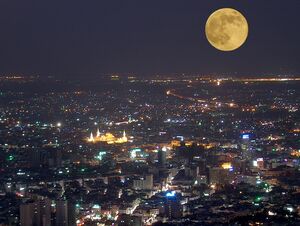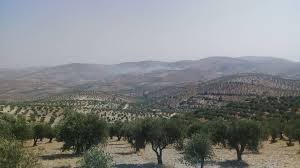Hawram
Hawram, is a province of Mansuriyyah, located in the western portion of the country.
Geography
Hawram is the largest province of Western Mansuriyyah, and is considered its historical and cultural heartland. The region consists mostly of arid plateaus, although the northwestn area is fairly green. The eastern slopes of the Qartaba mountains mark the region to the west, with the Badiyat al-Hawram desert to the east and the Shabb river to the south. Smaller mountains are scattered about the region.
The climate is predominantly dry, but winds from the Juwayqi bay carry some humidity to interior, especially the northern areas. A number of smaller rivers and streams flow down the mountains, emptying into small lakes and swamps in the interior. Forests make up only a very small percentage of Hawram’s total area and are primarily found in the mountains and around the coastal area.
History
Demographics
Depite the predominance of the Arab ethnicity, the region is fairly diverse, with significant Kanaani, Kurdish and Turanian minorities. A few Vainakh villages can be found scattered throughout, and in the south there’s a visible Mubatan influence.
The most important cities are Adra, a historic city which was Mansuriyyah’s first capital, and remain one of its main cultural centers, and Dayr Hafir, Hawram’s most important commercial and industrial center.
Economy
Wheat and cotton are the region's most important crops, with olives, grapes and apples grown in Qartaba’s eastern slopes, and citrus fruits cultivated along the bay’s short coast. Livestock is also an important agricultural activity, with sheep, cattle, camels and poultry being raised.
The region produces a modest quantity of oil and gas – the fields being a natural extension of Ahsa’s extensive oil and gas fields.
Industrialization started in the early 1800’s, but the region was economically surpassed by Adnaniyyah in the second half on the 19th century. A new wave of industrialization occurred during the Siduri war, when several key industries were transferred from Adnaniyyah to Hawram, to protect them from Syaran attacks. Textiles are Hawram’s most important industry, producing wool, cotton, nylon and silk. Chemical and industrial engineering products are also important. The region is also famous for its traditional manufactures, such as swords and blades, brass and copper work, wood engravings, gold and silver ornaments, mother-of-pearl inlays and silk brocades.
Hawram’s rich history, which includes ancient and classical ruins, religious sites and medieval architecture – some of which have been designed World Heritage Sites – attract a number of tourists every year.




